
Common Issues with Amana Washers
Amana washers often face issues like not turning on, constant running, or getting stuck in drain mode. Problems with water filling, leakage, and noisy operation are also common.
1.1. Washer Not Turning On
If your Amana washer won’t turn on, it could be due to a power supply issue or a faulty control board. First, ensure the washer is properly plugged into a working outlet. Check your home’s circuit breaker or fuse box to confirm the power supply is intact. If the washer still doesn’t start, the electronic control board might need replacement. Some users have reported success by unplugging the washer, waiting a few minutes, and then plugging it back in to reset the system. If these steps don’t resolve the issue, consult a professional or refer to the troubleshooting section of your user manual for further guidance.
1.2. Washer Not Stopping or Constantly Running
If your Amana washer won’t stop running or is stuck in a cycle, it may be due to a faulty timer or control board. First, unplug the washer to reset it. Plug it back in and check if the issue persists. If the washer continues running non-stop, ensure the lid switch is functioning properly, as some models require it to be closed for the cycle to complete. Additionally, check the user manual for specific troubleshooting steps. In some cases, the washer might be in “flood mode,” which occurs if it takes too long to fill with water. Resetting the washer by turning the dial and pressing start can often resolve this. If none of these steps work, a professional repair may be necessary to diagnose and replace faulty components like the control board or timer. Always refer to the manual for model-specific guidance.

Diagnostic Steps for Amana Washers
Begin by checking the power supply and ensuring all electrical connections are secure. Consult the user manual for troubleshooting guides specific to your model. Run a test cycle to identify issues and refer to error codes if displayed. Regularly cleaning filters and inspecting hoses can prevent common problems. Always unplug the washer before performing internal diagnostics or repairs. If issues persist, contacting a professional may be necessary.
2.1. Checking Power Supply and Electrical Connections
Ensure the washer is properly plugged into a functioning outlet. Verify that the circuit breaker or fuse box hasn’t tripped or blown; Check for loose or damaged power cords. If the washer still doesn’t turn on, consult the user manual for troubleshooting steps. Resetting the washer by unplugging it for 30 seconds may resolve minor electrical issues. Always ensure the power supply is stable before running a test cycle. If problems persist, contact a licensed electrician to inspect the electrical connections. Regularly inspecting these components can prevent unexpected malfunctions and ensure safe operation. Refer to the manual for specific guidance on diagnosing power-related issues for your Amana washer model.
2.2. Using the Troubleshooting Section of the User Manual
The troubleshooting section of the Amana washer manual is a valuable resource for diagnosing and resolving common issues. Start by identifying the specific problem your washer is experiencing, such as not turning on or constant running. Refer to the manual’s index or table of contents to locate the relevant troubleshooting guide. Many manuals include error code lists, which can help pinpoint the cause of malfunctions. Follow the step-by-step instructions provided, which may involve checking electrical connections, resetting the washer, or addressing water flow issues. If the manual recommends advanced repairs, consider consulting a professional. Regularly reviewing the troubleshooting section can help you address problems early and prevent further damage. Always ensure you have the correct manual for your specific Amana washer model for accurate guidance.

Error Codes and Their Meanings
Amana washers display error codes like F0, F1, or E1, indicating issues such as faulty sensors, power supply problems, or water flow malfunctions. These codes guide users to specific troubleshooting steps.
3.1. Understanding Common Error Codes
Amana washers use specific error codes to indicate malfunctions. Codes like F0, F1, or E1 often relate to issues such as faulty sensors, power supply problems, or water level discrepancies. These codes help users identify the root cause of the problem quickly. For instance, F0 might indicate a faulty control board, while E1 could signal a water level sensor issue. Understanding these codes is crucial for effective troubleshooting. Users can find detailed explanations of these codes in the troubleshooting section of the user manual. By referencing these codes, homeowners can perform basic diagnostics, such as checking power connections or ensuring proper water flow, before deciding whether professional repair is needed. This approach saves time and helps resolve issues efficiently. Always consult the manual for specific code meanings and solutions.
3.2. Resetting the Washer After an Error
Resetting an Amana washer after an error can often resolve issues. Start by unplugging the washer from the power outlet for 30 minutes to reset the control board. Alternatively, press and hold the START button for 5-10 seconds to restart the cycle. If the washer is in error mode, ensure all lights are off before attempting a reset. For models with a digital display, entering a diagnostic mode may be necessary. After resetting, run a test cycle to confirm the issue is resolved. If problems persist, refer to the user manual for specific reset instructions or consider professional assistance. Regular resets can help maintain the washer’s functionality and prevent recurring errors. Always follow safety guidelines when performing resets to avoid further complications.
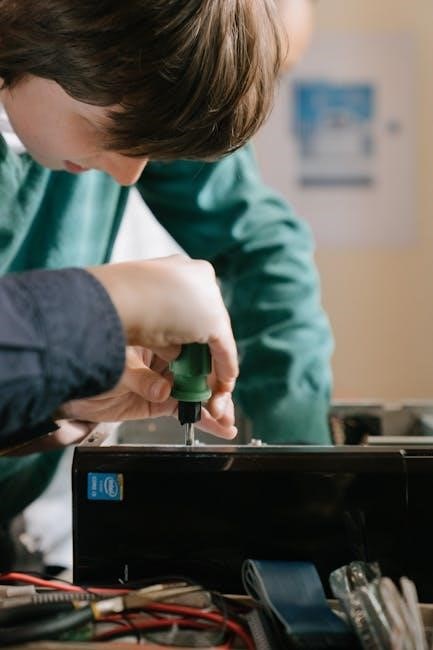
Water-Related Problems
Amana washers may face water-related issues such as not filling, leaking, or overfilling. These problems often stem from faulty valves, clogged hoses, or sensor malfunctions, disrupting wash cycles.
4.1. Washer Not Filling with Water
If your Amana washer isn’t filling with water, check the water supply hoses for kinks or blockages. Ensure the water valves are fully open and not restricted. Faulty inlet valves or a malfunctioning water level sensor can also cause this issue. Additionally, a clogged filter screen in the water inlet can prevent proper filling. To resolve, turn off the water supply, inspect and clean the filter screens, and ensure all connections are secure. If the problem persists, replacing the inlet valve or sensor may be necessary. Always refer to your user manual for specific troubleshooting steps and safety precautions.
4.2. Washer Leaking or Overfilling
Amana washers may leak or overfill due to issues like a faulty water level sensor, malfunctioning inlet valves, or a clogged drain hose. If the sensor fails, the washer may not detect the correct water level, causing overfilling. Similarly, a stuck inlet valve can prevent water from shutting off properly. To address this, check the drain hose for blockages and ensure it’s properly positioned. Resetting the washer by unplugging it for 30 minutes may resolve sensor-related issues. If the problem persists, replacing the water level sensor or inlet valve might be necessary. Always consult the user manual for specific troubleshooting steps and safety guidelines to avoid further damage.

Drainage Issues
Amana washers may face drainage problems like being stuck in drain mode or having a clogged drain hose. Check for kinks or blockages in the hose or pump filter.
5.1. Washer Stuck in Drain Mode
If your Amana washer is stuck in drain mode, it may indicate a malfunction in the water level sensor or a faulty drain pump. First, unplug the washer to reset it. If the issue persists, check for blockages in the drain hose or pump filter. Ensure the drain hose is properly installed and not kinked. Additionally, verify that the water level pressure switch is functioning correctly. If these steps don’t resolve the problem, it may be necessary to replace the electronic control board or seek professional assistance. Regular maintenance, such as cleaning the pump filter, can help prevent this issue from occurring.
5.2. Clogged Drain Hose or Pump Filter
A clogged drain hose or pump filter is a common issue in Amana washers, causing water to remain in the tub. Check the drain hose for kinks or blockages and ensure it’s properly installed. Remove any debris from the pump filter, as items like lint, coins, or small objects can obstruct water flow. Regularly cleaning the pump filter and drain hose can prevent this problem. If the issue persists, inspect the drain pump for damage or malfunction. Replacing the pump filter or drain hose may be necessary if they are severely clogged or worn out. Always refer to your user manual for specific instructions on accessing and cleaning these components. Regular maintenance can help avoid costly repairs and ensure smooth operation.
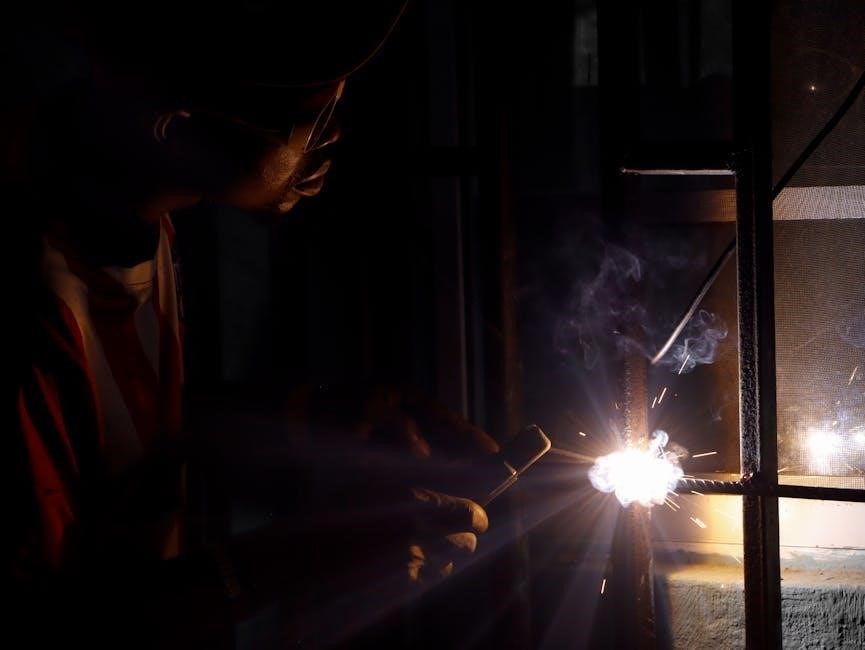
Noise and Vibration Problems
Amana washers may produce unusual noises or vibrations during operation. Common causes include imbalanced loads, loose mounting parts, or worn-out components like bearings or belts. Regular maintenance helps mitigate these issues.
6.1. Unusual Noises During Operation
Amana washers may emit unusual noises during operation, such as clunking, rattling, or grinding sounds. These noises often indicate issues like an imbalanced load, loose components, or worn-out parts. For example, a clunking sound could suggest a faulty bearing or an unbalanced drum, while rattling might point to debris in the drum or a loose belt. Grinding noises may indicate problems with the motor or gearbox. Regular maintenance, such as checking and tightening loose parts, cleaning the drum, and ensuring proper load balance, can help minimize these issues. Addressing these problems early prevents further damage and ensures smoother operation.
6.2. Excessive Vibration During Spin Cycle
Excessive vibration during the spin cycle is a common issue with Amana washers. This problem is often caused by an uneven load, misbalanced drum, or unstable installation. If the washer is not level, it can vibrate excessively, leading to noise and potential damage. Additionally, worn-out shock absorbers or faulty balance springs can contribute to this issue. To resolve it, ensure the washer is properly leveled using its adjustable legs. Redistribute the laundry load to achieve balance and avoid overloading. Checking and replacing worn-out components, such as shock absorbers, can also help reduce vibration. Regular maintenance and ensuring the washer is installed on a firm, even surface are key to preventing this problem.
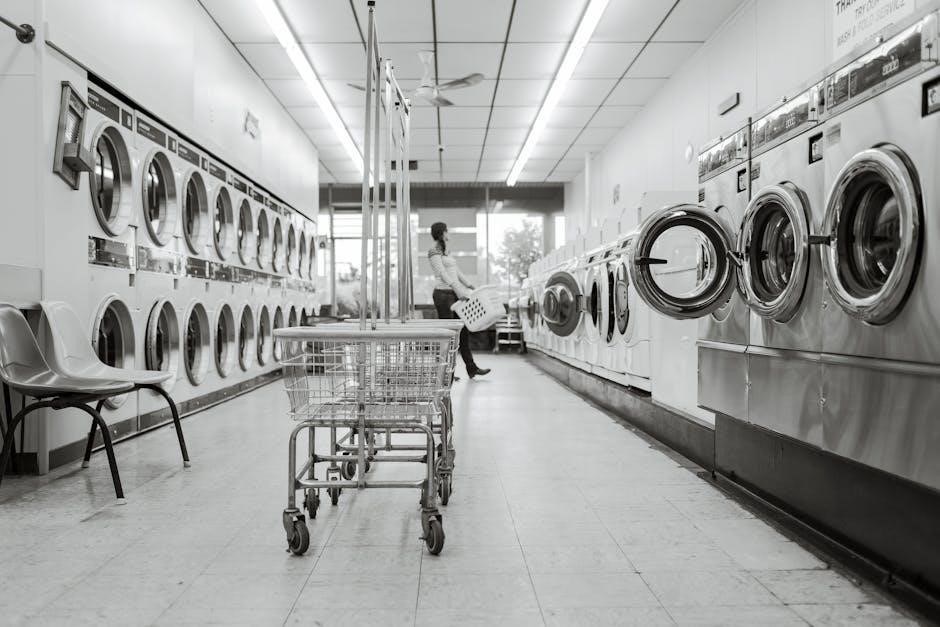
Maintenance Tips to Prevent Issues
Regularly clean the washer interior, check hoses for leaks, and ensure proper installation. Balanced loads and routine checks of belts and pulleys help prevent mechanical failures and extend lifespan.
7.1. Cleaning the Washer Regularly
Regular cleaning is essential to maintain your Amana washer’s performance and prevent odors. After each use, leave the lid open to dry the interior. Every 1-2 months, run a cleaning cycle with a washer cleaner or vinegar to remove detergent residue and mildew. Check and clean the drain pump filter regularly to avoid clogs and ensure proper drainage. Wipe down the exterior and gasket with a mild detergent to prevent mold buildup. Regularly inspect and clean the detergent dispenser to ensure proper flow. These simple steps help prevent common issues like odors, mold, and poor drainage, ensuring your washer runs efficiently and lasts longer. Consistent maintenance also reduces the risk of costly repairs and keeps your clothes cleaner;
7.2. Checking and Replacing Worn-Out Parts
Regularly inspecting and replacing worn-out parts is crucial for maintaining your Amana washer’s performance. Check the water valve assembly, drain pump filter, and electronic control board for signs of wear or damage. Inspect hoses for cracks or blockages and replace them if necessary. Clean or replace the drain pump filter every 1-2 months to prevent clogs. If you notice unusual noises or vibrations, check the balance or suspension parts. Refer to your user manual for guidance on locating and replacing specific components. Replace worn-out belts or seals promptly to avoid leaks or operational issues. For complex parts like the control board, consider consulting a professional. Regular inspections and timely replacements can prevent breakdowns and ensure your washer runs efficiently for years. Consistent maintenance also helps extend the lifespan of your appliance and avoids costly repairs. Always use genuine Amana replacement parts for optimal performance.

Repair and Replacement Options
For Amana washer repairs, consider DIY fixes for minor issues or hire a professional for complex problems. Replace worn parts like water valves or control boards. Use genuine replacement parts for optimal performance and longevity. Check online marketplaces or authorized dealers for authentic components. Regular maintenance can prevent costly repairs. Always follow safety guidelines when performing DIY repairs to avoid further damage or injury. Ensure proper installation of new parts to maintain warranty validity and appliance efficiency.
8.1. DIY Repairs vs. Professional Service
Deciding between DIY repairs and professional service for your Amana washer depends on the issue’s complexity. Simple fixes, like replacing a worn belt or cleaning the drain hose, can often be done at home with basic tools. However, complex problems, such as faulty electronic control boards or water valve replacements, may require professional expertise to avoid further damage. DIY repairs can save money but may void warranties if not done correctly. Professional services ensure proper repairs and maintain warranty validity. Always consult the user manual or online guides for guidance. If unsure, contacting a certified technician is recommended to prevent safety risks and ensure long-term appliance performance.
8.2. Finding Replacement Parts Online
Locating genuine replacement parts for your Amana washer is essential for reliable repairs. Websites like RepairClinic.com and Amana’s official parts store offer a wide range of components. When searching, use your washer’s model number to ensure compatibility. Popular parts include water valves, control boards, and drain pumps. Online marketplaces like Amazon and eBay also carry Amana parts, but verify seller ratings and reviews to avoid counterfeit items. For convenience, many retailers provide detailed part descriptions and installation guides. Always check for warranties or return policies before purchasing. This ensures you receive the correct part and can address any issues quickly, keeping your washer in optimal condition.
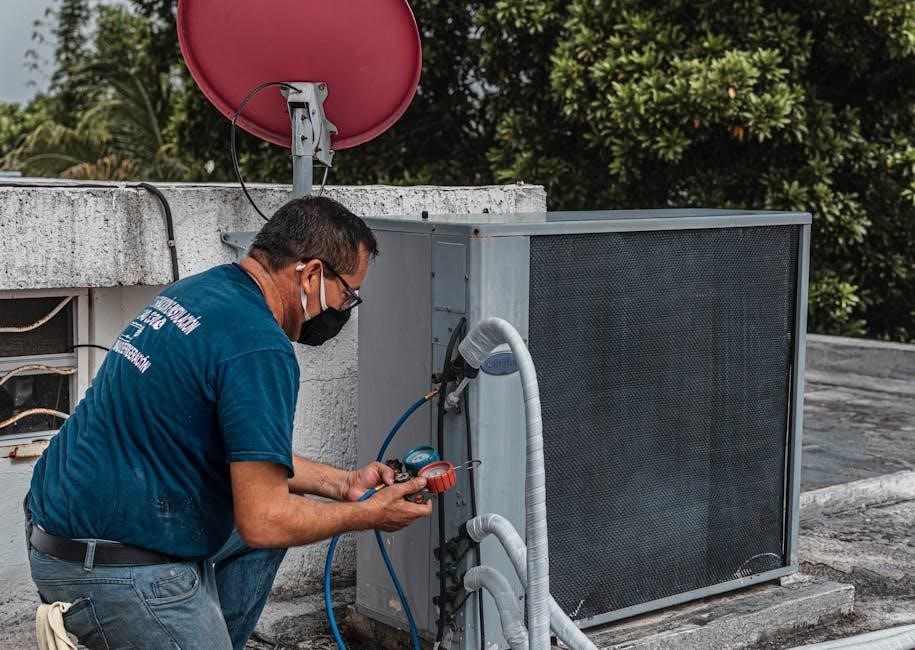
User Manual and Online Resources
Accessing the Amana washer manual is crucial for troubleshooting. Visit the official Amana website or use their manual search tool by entering your model number for quick access.
9.1. How to Find and Use the Amana Washer Manual
To locate the Amana washer manual, visit the official Amana website and use the manual search tool by entering your specific model number, such as NTW4651BQ0 or NTW4516FW. Once found, the manual provides detailed troubleshooting guides, error code explanations, and maintenance tips. It also includes diagrams and step-by-step instructions for resolving common issues like the washer not turning on or getting stuck in drain mode. Referencing the manual can help diagnose problems before calling a professional, ensuring efficient repairs and prolonging the appliance’s lifespan. Regularly reviewing the manual helps prevent issues by outlining proper usage and care practices.
9.2. Online Tutorials and Repair Guides
Online tutorials and repair guides offer valuable resources for troubleshooting Amana washers. Websites like RepairClinic.com provide detailed repair videos and step-by-step instructions for common issues, such as replacing the water valve or fixing the control board. YouTube channels and forums often feature DIY solutions shared by experienced technicians and users. For specific models like the NTW4651BQ0 and NTW4516FW, online guides address problems like continuous running or drain mode issues. These resources help users identify faulty parts and perform repairs confidently. Additionally, Amana’s official website offers video tutorials for maintenance and operation. By leveraging these online tools, users can resolve issues efficiently, potentially avoiding costly professional services.
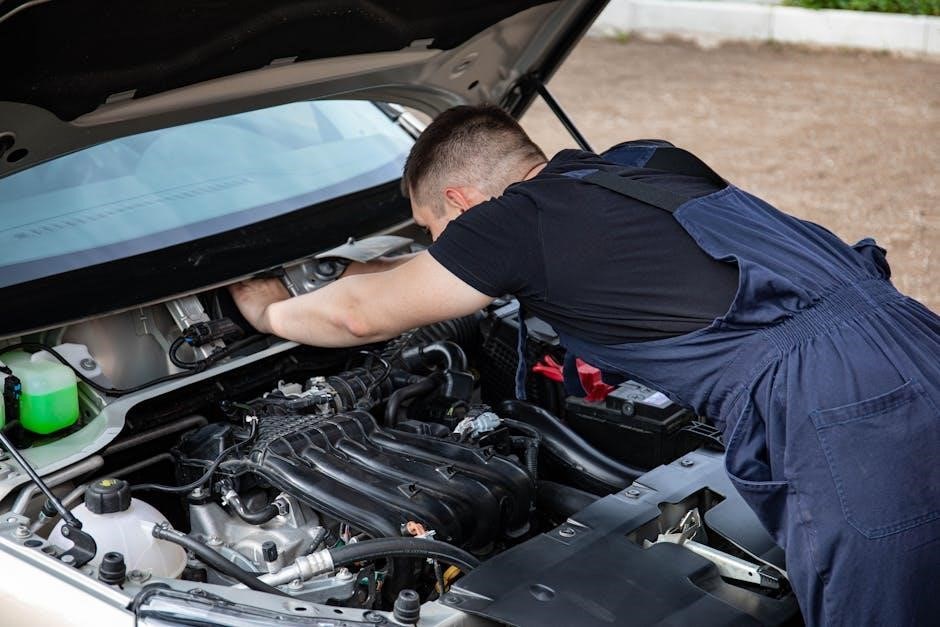
Model-Specific Troubleshooting
Model-specific issues for Amana washers, like the NTW4651BQ0 and NTW4516FW, include problems such as constant running or drain mode stuck. Checking the user manual or online guides can help resolve these issues efficiently.
10.1. Troubleshooting the Amana NTW4651BQ0 Model
The Amana NTW4651BQ0 model often experiences issues like the washer not stopping after the cycle ends. This can be due to faulty sensors or control board malfunctions. Users have reported that resetting the washer by unplugging it or holding the start button can sometimes resolve the issue. Additionally, ensuring proper power supply and checking electrical connections are crucial first steps. If the problem persists, consulting the user manual or seeking professional help is recommended. Regular maintenance, such as cleaning the drain pump and checking water valves, can also prevent recurring problems. Online forums and repair guides provide detailed solutions for model-specific troubleshooting.
10.2. Common Issues with the Amana NTW4516FW Model
The Amana NTW4516FW model frequently encounters issues such as getting stuck in drain mode, where the washer continuously attempts to drain without progressing. Users have reported that this problem can occur due to clogged drain hoses or faulty sensors. Additionally, some owners have experienced difficulties with the control board, leading to unexpected behavior during cycles. In such cases, resetting the washer by unplugging it or holding the cancel button may temporarily resolve the issue. It’s also important to check the water supply lines for proper connection and ensure the drain hose is not kinked. Consulting the user manual or online repair guides can provide specific solutions for this model. Regular maintenance, such as cleaning the drain pump filter, can help prevent these issues from recurring.
